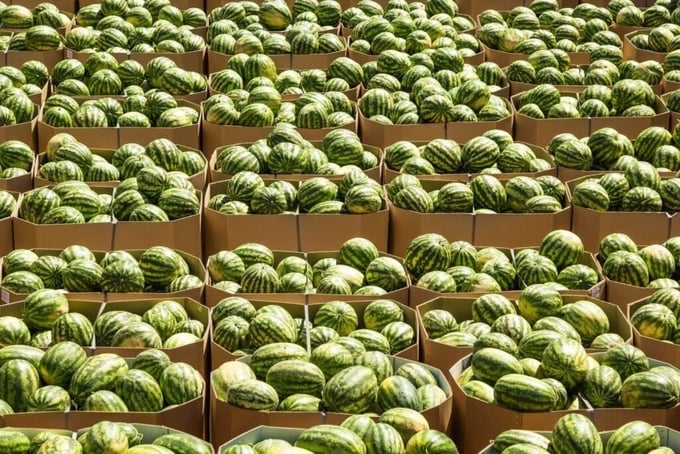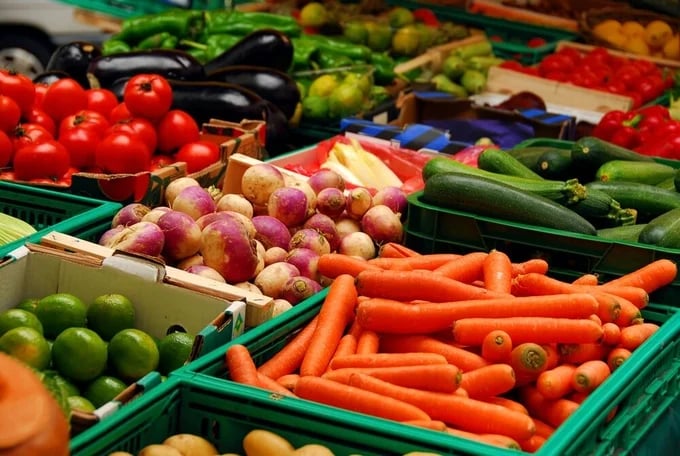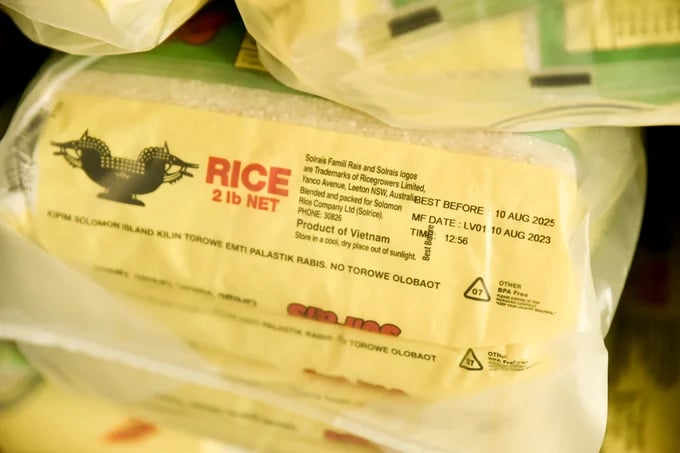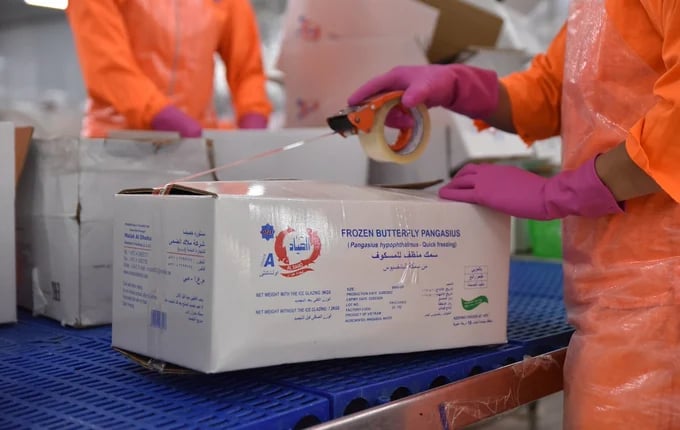(VAN) Vietnam SPS Office (Ministry of Agriculture and Rural Development) updates food safety and animal and plant quarantine measures in Europe, China, South Korea, Japan, Australia, and New Zealand.

Dr. Dao Van Cuong, Vietnam SPS Office, Ministry of Agriculture and Rural Development, informed us about the latest updates on international SPS regulations. Photo: Nguyen Thuy.
European Union market
Over the years, the EU market has introduced regulations to help ensure consumer safety and contribute to protecting the environment and natural resources. Vietnamese businesses must understand and comply with these regulations to export goods to the EU market sustainably and effectively.
The most important legislation is Regulation (EU) No 178/2002, known as the EU Common Food Law. It sets out the general principles and rules for food safety in the EU, which apply to all stages of food production, processing, and distribution from farm to fork.
The EU Deforestation Reduction Regulation (EUDR) will be applied from January 2025, with small businesses only from June 2025. This regulation prohibits the import of seven groups of products, including coffee, palm oil, timber, rubber, beef, cocoa, and beans, into the EU if their production causes deforestation.
Regulation No. 1005/20081 (IUU) was enacted on 1 October 2010 to combat illegal, unreported, and unregulated fishing.
Regulation (EU) No 2019/1793 applies provisional official control and emergency measures to certain foods imported into the EU.
Regulation (EU) 2022/2292 of 06 September 2022 supplements Regulation (EU) 2017/625, which stipulates that for compound food products containing ingredients of animal origin, the animal ingredient must be included in the list of establishments (approved countries) authorized to export animal products to the EU.
Chinese market
In the Chinese market, regulations on maximum residue levels (MRLs) for pesticides play an important role in ensuring food safety.
China does not have a default MRL policy and maintains a national MRL List, which does not apply standards from other markets or CODEX. China’s MRL standards are updated every two years, with changes mainly consisting of the addition of new MRLs. MRL proposals are notified to the WTO throughout the year, but it typically takes one to two years for draft provisions to be adopted.
The formulation and regulation of pesticide MRL standards is the responsibility of the Agricultural Chemicals Control Institute of the Ministry of Agriculture (MARD). The State Administration for Market Regulation (SAMR) also plays an important role in formulating and implementing major food safety policies and regulations, jointly publishing GB 2763 with MARA and the National Health Commission of China (NHC). The General Administration of Customs (GACC) supervises and enforces MRL regulations in China.

Vietnamese enterprises need to understand and comply to export goods to large markets sustainably and effectively. Photo: Tung Dinh.
Some important food safety standards include:
GB 2763 – National Food Safety Standard for Maximum Residue Limits for Pesticides in Food. GB 23200.116 – National Food Safety Standard for Determination of 90 Pesticides and Their Organic Metabolites Residues in Plant-Origin Foods, Using Gas Chromatography. GB 23200.117 – National Food Safety Standard for Determination of Oxine-Copper Residues in Plant-Origin Foods, Using High-Performance Liquid Chromatography.
In the GB 2763 – National Food Safety Standard on Maximum Residue Limits for Pesticides in Food, there are some important amendments compared to the previous version to improve food safety standards.
First, the acceptable daily intake (ADI) for 21 pesticides will be adjusted. For example, the ADI for abamectin will be revised from 0.002 mg/kg body weight to 0.001 mg/kg body weight.
Next, the standard will add maximum residue limits for 51 pesticides, such as 2,4-D-dimethylamine. This will help to manage pesticide residue levels in food more closely.
In addition, 28 existing maximum residue limits for pesticides in food will be revised to suit the actual situation better and ensure consumer safety.
GB 2763 will also introduce 25 new testing standards for determining pesticide residue levels in food, providing a scientific and technical basis for more effective food safety inspection and supervision.
In particular, 11 new pesticides will be added to the List of Pesticides Exempted from Maximum Residue Limits in Food. These pesticides will be exempt from maximum residue limits. Some examples include Bacillus thuringiensis, Pseudomonas fluorescens and Bacillus subtilis.
These updates and revisions demonstrate China’s efforts to strengthen food safety control, protect consumer health and ensure that food meets the highest quality standards.
South Korean market
In the South Korean market, food safety regulations and maximum residue levels (MRLs) for pesticides play an important role in ensuring the quality and safety of imported products.
In general, South Korea applies the provisions of the Imported Food Safety Control Act promulgated on March 28, 2017 and the Special Act on Imported Food Safety Control promulgated on October 8, 2020. These regulations lay the foundation for controlling the quality and safety of imported foods, ensuring that they meet South Korea’s strict standards.

Food imported into South Korea will undergo strict inspection steps. Illustration photo.
For Maximum Residue Levels (MRLs), South Korea has implemented the Positive List System (PLS) since January 1, 2019. Under the PLS, South Korea will apply a general default MRL of 0.01 mg/kg if an unregistered pesticide sets an MRL. This ensures that unregistered pesticides do not have significant residues in food, protecting consumers from potential risks.
In addition, food imported into South Korea will undergo strict inspection steps under the PLS System, including document checks and on-site inspections of the shipment. The frequency of in-depth inspections will depend on the specific situation of each shipment to ensure that imported food always meets safety standards.
For food additives, South Korea applies standards and regulations issued on November 13, 2020. These standards specify the types of additives that are allowed to be used and their safety levels, ensuring that imported food products do not contain additives that are harmful to health.
Japanese market
In the Japanese market, detailed laws and regulations related to food safety, plant protection, and quarantine ensure product quality and safety. Enterprises exporting to Japan need to understand and comply with these regulations to meet the strict standards of the market.
The Plant Protection Act sets out regulations for protecting plants from pests and diseases.
The Quarantine Law prescribes measures for the control of animals and plants to prevent the entry and spread of harmful species from abroad.
Agricultural Chemicals Regulations control the use of chemicals in agriculture, ensuring they are used safely and effectively.
The Law on Protection of Plant Varieties and Seeds aims to protect intellectual property rights for new plant varieties and ensure the quality of seeds.
The Food Hygiene Law regulates hygiene and safety standards for food, from production, processing to distribution.
The Consumer Product Safety Act ensures that consumer products, including food, are safe for human consumption.
The Basic Law on Food Safety sets out basic principles and requirements for food safety and helps coordinate various regulations related to it.
Fisheries Law regulates fishing activities to protect aquatic resources and ensure food safety from the sea.
The Domestic Animal Infectious Disease Control Act provides measures to control infectious diseases in animals to protect public health and the livestock industry.
The Slaughterhouse Law, the Slaughterhouse Management Law, and the Poultry Inspection Law prescribe hygiene and safety standards during slaughter and meat processing.
The Toxic and Hazardous Substances Control Act controls the use and management of toxic substances to protect human health and the environment.
The Japanese Agricultural Standards Law sets quality and safety standards for agricultural products.
In addition, other detailed decrees and regulations supplement and guide the implementation of the above laws.
Australian and New Zealand market
The Australian and New Zealand Food Standards Code sets food safety standards in the Australian and New Zealand markets. All food imported into Australia must comply with these requirements, and it is the importer’s responsibility to ensure that imported food meets Australian food safety standards.

The Australia and New Zealand Food Standards Code has specific regulations on product labeling. Photo: Quynh Chi.
The Australia New Zealand Food Standards Code is divided into four chapters, each containing detailed provisions on different aspects of food safety:
Chapter 1 – Introduction and standards applicable to all foods: This chapter covers labeling requirements, food additives and supplements, maximum residue limits, genetically modified foods, microbiological limits, and processing requirements. These regulations ensure that foods are accurately labeled and do not contain harmful substances in excess of permitted levels.
Chapter 2 – Food Product Standards: This chapter specifies the compositional requirements for specific foods. Each food must comply with compositional standards to ensure quality and safety for consumers.
Chapter 3 – Food Safety Standards: This chapter sets out food safety requirements for food handlers. This includes hygiene controls, working conditions and occupational health and safety regulations during food processing.
Chapter 4 – Basic Production Standards: This chapter covers standards for agricultural products, which prescribe production methods to ensure that agricultural products are of the highest quality and safe for consumption.
Some noteworthy SPS announcements
Australian Notice No. G/SPS/N/AUS/586 dated 12/4/2024: This notice relates to “Import Risk Assessment for Pre-Dehydrated and Pre-Sterilized Microbiological Media” to ensure that pre-dehydrated and pre-sterilized microbial products imported into Australia meet safety standards and do not pose a risk to the environment and public health.
Notice No. G/SPS/N/AUS/570/Add.1 dated 07/03/2024 of Australia: The content of this notice states that the Australian Department of Agriculture, Fisheries and Forestry has completed a risk analysis to meet the market access requirements for fresh passion fruit (Passiflora edulis) imported into Australia from Vietnam.
Australian Notice G/SPS/N/AUS/583 dated 19/03/2024: This notice proposes to amend the Food Standards Australia and New Zealand to adjust the maximum residue limits (MRLs) for various agricultural and veterinary chemicals. These chemicals include ametoctradin, cypermethrin, ethephon, fluxapyroxad, ipflufenoquin, mefentrifluconazole, metalaxyl and pyraclostrobin in plant commodities, as well as bupivacaine and lignocaine in certain animal commodities.
New Zealand Notice G/SPS/N/NZL/742/Add.1 dated 31 January 2024: New Zealand has notified amendments to the Import Health Standards for rambutan, fresh ginger and fresh fruit and vegetables. These amendments will come into effect on 29 January 2024, to ensure that these imported products meet New Zealand’s food safety and quarantine standards.
Notice No. G/SPS/N/KOR/798 dated March 13, 2024 of South Korea: South Korea proposes to amend the “Aquatic Organism Disease Control Act” to strengthen disease control measures for aquatic organisms, ensure biosafety, and prevent the spread of diseases in the aquatic environment.
Notification No. G/SPS/N/KOR/797 dated March 5, 2024 of South Korea: Proposed revision of “Standards and specifications for food utensils, containers and packaging” to ensure that food utensils and packaging meet safety and hygiene standards, prevent food contamination and protect consumer health.
Notice No. G/SPS/N/JPN/1258 dated March 1, 2024 of Japan: The content of this notice amends the Management List of Living Organisms under the Invasive Alien Species Act.

Businesses need to pay attention to and update food safety measures and animal and plant quarantine in Europe, China, South Korea, Japan, Australia, and New Zealand. Photo: Quynh Chi.
Notice No. G/SPS/N/CHN/1298, dated February 12, 2024 of China: The notice’s content is related to the “National Food Safety Standard of the People’s Republic of China: Vitamin K2 Food Nutritional Fortifier (Synthesis Method).” This standard applies to vitamin K2 nutritional fortified foods prepared by chemical synthesis from vitamin K3 and heptaenorpene alcohol or from vitamin K3, farnesol, and geraniol as raw materials.
Notice No. G/SPS/N/CHN/1297 dated February 12, 2024 of China: Refers to “National Food Safety Standards of the People’s Republic of China: General Rules for Food for Special Medical Purposes.” This standard prescribes the relevant technical indicators of food for particular medical purposes, applicable to foods for people over one-year-old.
Notice No. G/SPS/N/CHN/1296 dated 12/02/2024 of China: The content of this notice is related to “National Food Safety Standards of the People’s Republic of China: Complete Complementary Food.” This standard applies to complementary foods for children aged six months to 36 months and children aged 37 months to 72 months, ensuring that they meet the necessary nutritional requirements of children at different stages of development.
Notice No. G/SPS/N/CHN/1295 dated February 9, 2024, of China: This notice refers to “National Food Safety Standards of the People’s Republic of China: General Principles for Labeling Prepackaged Foods”. This standard specifies the food labeling requirements for prepackaged foods, ensuring that the information on the label is clear and complete.
Notice No. G/SPS/N/CHN/1301, dated June 28, 2024, of China: The notice content is adding 47 pests, including Amyelois tarantella (Walker) moth and other pests, to the list of plant quarantine objects.
Notice No. G/SPS/N/CHN/1311, dated July 11, 2024, of the National Health Commission of China: Notice content on regulations on acrylamide pollution control in food. This standard specifies the basic requirements and management guidelines for the prevention and control of acrylamide generation in potato products, roasted cereal products, coffee, etc. through the control of raw materials and thermal processing such as frying and roasting.
Agriculture News | Agri Products Price



